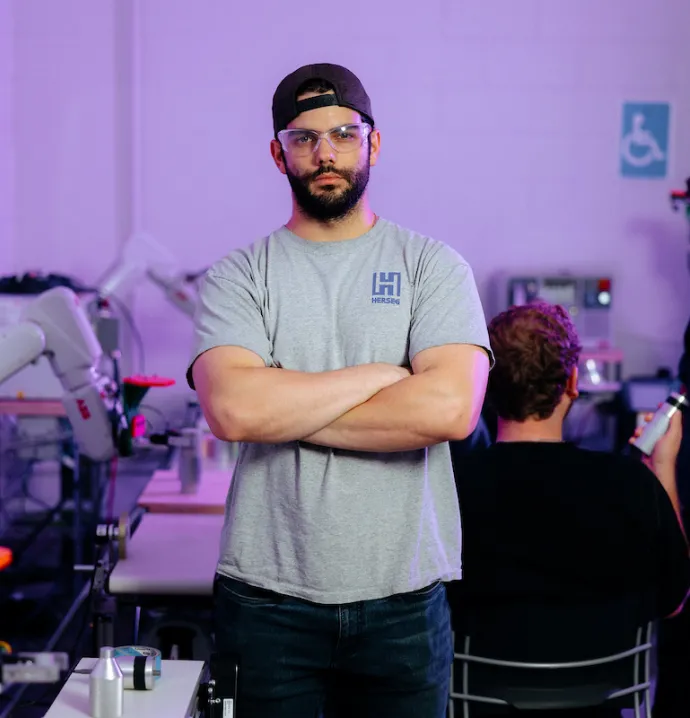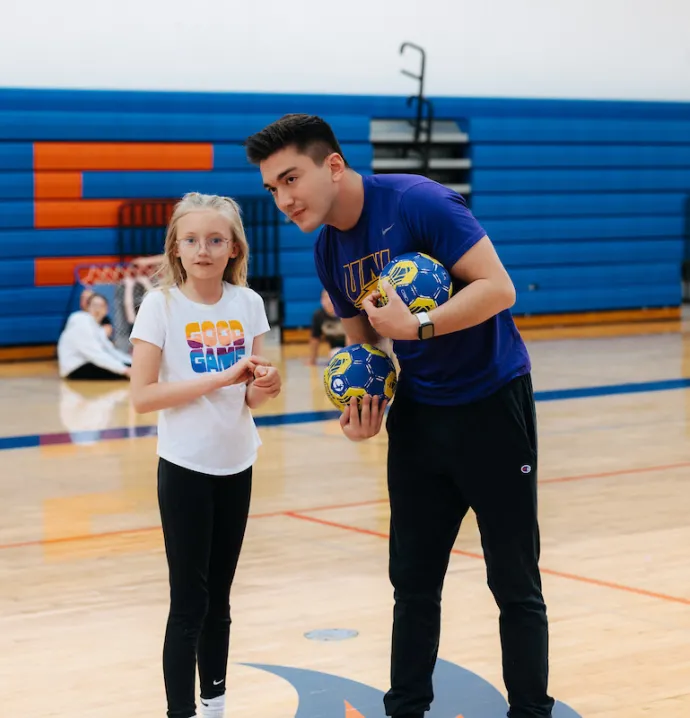Coming back from the unknown
Coming back from the unknown
Maddy Miller was laying in her coffin, trapped in her catatonic body, as she heard her family’s pastor arrive at her bedside, presumably to read her last rites. He joined Miller’s parents in prayer. The sounds of Miller’s guttural screams following him as he walked away. She thought she was dying; that she was already dead.
As far as she’s concerned, she may as well have been — Miller has no memory of that time in her life. She doesn’t remember pinning a nurse against a wall. She doesn’t remember accusing her mother of trying to kill her. She doesn’t remember running up and down the halls of the hospital, shouting, “They’re going to get me!” She doesn’t remember crawling out of an MRI machine, ripping IVs out of her body.
All she remembers is the panic she felt at paranoid thoughts that the “bad guys” were out to get her; that her doctors and nurses were trying to poison her; that she was being wheeled away to an incinerator to be cremated. In reality, the medical staff of the two hospitals she found herself in were trying to help her — connecting her to feeding tubes and wheeling her to MRI machines to run tests to figure out what was wrong.
Because nobody knew what was wrong, just that mysterious symptoms had been plaguing Miller for months. And Miller didn’t even know what was happening — her mind was a mix of paranoid delusions and hallucinations. Even today, she has no recollection of this chaotic time in her life. Even after finally receiving a proper diagnosis and successfully completing treatment, there are months of her life that will remain unknown.
Strange behavior
Part of the mystery of Miller’s condition was that her symptoms could have easily been explained away as signs of stress or sleep deprivation — things many college students are familiar with. And as a first-year communication sciences & disorders major beginning her second semester of studies, it made sense that she might be a little overwhelmed. She was behaving strangely, but it seemed like she just needed some rest. But for Miller, that was the most alarming symptom — she was taking a lot of naps.
“I would study for ten minutes at a time and need to take a nap and that's just not who I am,” said Miller. “I’m a 4.0 student and I really pride myself on that. It was just odd to need to rest that much. I would walk out of classes and into the fresh air just to wake myself up.”
In the weeks before being hospitalized, she was also sending nonsensical text messages and obsessing about an upcoming exam. Her behavior grew increasingly strange, her texts became pure gibberish and her stress about her exam grew to full-on paranoia. At one point, she was so disoriented, she forgot how to tie her laces.
That day, she walked to work with untied shoes and without wearing her glasses, and that’s when her friends knew something was going on. Miller herself began telling friends she believed she had a brain tumor but “didn’t have time to take care of it yet.” That’s when her family intervened. Her parents drove 45 minutes from Miller’s hometown of New Hampton, IA, to see what was going on. Ironically, they ended up pulling Miller from the very test she had been obsessing over.
“They pulled me out of class and forced me to the hospital. I really didn’t want to go,” Miller said. “But they thought it was something that medication could fix in a day. They didn’t know it’d be quite the episode that it was.”
Finding an answer, finding hope
The following weeks were a flurry of MRIs and medication cocktails and misdiagnoses. Miller had been in the emergency room and ICU at Covenant Medical Center in Waterloo, in the pediatric neurology ward at the University of Iowa Hospitals and Clinics (initially, the only place UIHC could find a bed for Miller) and seemed to be headed to the psychiatric ward due to her increasingly unruly behavior.
But she found herself in the adult neurology ward at UIHC when hope finally came. The same day she was scheduled for a brain biopsy in a last attempt at diagnosis, doctors approached Miller with a diagnosis of anti-NMDA receptor encephalitis (anti-NMDAR encephalitis), a rare neurological autoimmune disease that can cause seizures, hallucinations, memory loss and even death.
“I had never heard of the disease. It was first identified in 2007, so there’s a large amount still unknown,” she said. “It’s an autoimmune disease, so your body is attacking itself. Your immune system is basically attacking your brain.”
After finally receiving a proper diagnosis, Miller went into treatments — but it still wasn’t an easy road. While treatment is generally successful in patients with anti-NMDAR encephalitis, finding an effective treatment option takes time, and it can take several months, even years to fully recover — and full recovery isn’t always possible. Early intervention is key, so there’s always the risk that the proper treatment won’t be found in time. The first round of treatments is usually steroids and IVIG plasma transfusion, which are less harsh than the more effective chemotherapy treatments. Unfortunately, for Miller, steroids and transfusions didn’t work.
“I would come through and act normal for a little while, but quickly relapse,” she said.
During one rare moment of clarity, Miller turned to her aunt, who would frequently make visits during her lunch breaks, and told her she was afraid “of being like this forever.” The glimmer of hope that came when she finally received a proper diagnosis was starting to fade.
The doctors attempted chemotherapy treatments next. Thankfully, these treatments were successful, and Miller’s cognitive function saw a quick and dramatic turnaround after the first few rounds of treatments. She wasn’t completely cured — she still showed some symptoms, including dyskinesias, which are erratic, involuntary body movements — but she could speak properly and accurately perceive reality for the first time in a long time. The “bad guys” were gone.
The path to recovery
Not everyone is as lucky as Miller — while treatment for the disease is usually successful if administered in time, not everyone gets diagnosed or has access to the appropriate treatments in time to make a full recovery. Miller witnessed this first-hand at the hospital, and it was a reminder of how lucky she was — but also of the struggles she had yet to face on her path to recovery.
“There was a person at UIHC at the same time I was, with the same diagnosis, and they caught her disease at a later stage, so I was in and out of the hospital faster than she was. She was there after I left and she had been there months prior,” said Miller. “In that sense, it’s really humbling. It makes you realize how blessed you are. It could have been much, much worse for me.”
However, this also served as a reminder of how far she had left to go. Despite seeing quick improvement in her cognitive function, Miller still received inpatient physical therapy to relearn walking patterns, after muscle deconditioning resulting from her hospitalization, and required months of outpatient cognitive therapy. And there’s also the looming risk of relapse casting a shadow on her success — there is a 14-24% of relapse for anti-NMDAR encephalitis patients.
“It’s always in the back of your mind that it could happen again. Whenever you get a headache, you’re like, ‘Should I be concerned?’” said Miller. “Typically, I just let my friends and family know, ‘Hey, I’m not feeling good today, just in case something happens.’ You have to live knowing something could. But you don’t want the diagnosis to control you.”
Regaining control, making peace with the unknown
Part of Miller’s outpatient treatments included two months of cognitive therapy with a speech-language pathologist. It was a difficult, but interesting, experience for Miller, who’s studying to become a speech-language pathologist herself.
“The cognitive therapy was probably the most difficult for me. You don’t want to admit your faults, but the first step is admitting that you need help.” she said. “I think it challenged my therapist a little bit, too, to be like, ‘Oh, this is a student. She might know these tests I’m giving her, she might know these procedures,’ so she maybe had to alter it a little bit.”
Ultimately, Miller successfully completed treatments — and successfully completed her undergraduate studies, despite such a difficult end to her first year. She’s now in her last year of graduate studies for her master’s in speech-language pathology.
“I give a lot of credit to the professors and UNI in general. I don’t think a lot of universities would have encouraged me to finish the semester, but my professors were all so fantastic. They worked with me through the summer,” she said. “That just speaks to how awesome UNI is in that aspect. I don’t think I could have been able to do it without them, and the work ethic my parents instilled in me.”
Miller did work hard to catch up on her school work — even staying after her own cognitive therapy appointments to log observation hours for school. This is not only a result of the work ethic she’s always had, but also a direct result of her experience with anti-NMDAR encephalitis, which helped her feel more secure in her area of study.
“I had in my mind already that I was going to become a speech-language pathologist, but it validated why I chose the major,” she said. “I was able to see everything through a patient perspective rather than through a clinician perspective. I think it helped me gain a lot of empathy.”
And even though she’s gained confidence in her subject area and would love to work with neurological illnesses in a medical setting, she’s keeping her options open. Speech-language pathologists can work in hospitals, schools and long-term care facilities, and Miller is willing to explore new things. In fact, the open possibilities are what’s exciting her the most these days. Where the “unknown” frustrated her in the lack of memories she has about her experience with anti-NMDAR encephalitis, when thinking about her future, it excites her.
“I think my parents are grateful that I don’t have memory, just because it was so painful for them. It is kind of frustrating that I don’t know what happened, but when I look back on it, I try to see it as more of a learning experience,” she said. “I think the biggest life lesson is you might be set back in life but you can overcome — the comeback is always stronger than the setback. I think it’s kind of fun that I have a choice of where I want to end up. I’m kind of looking forward to the unknowns.”




